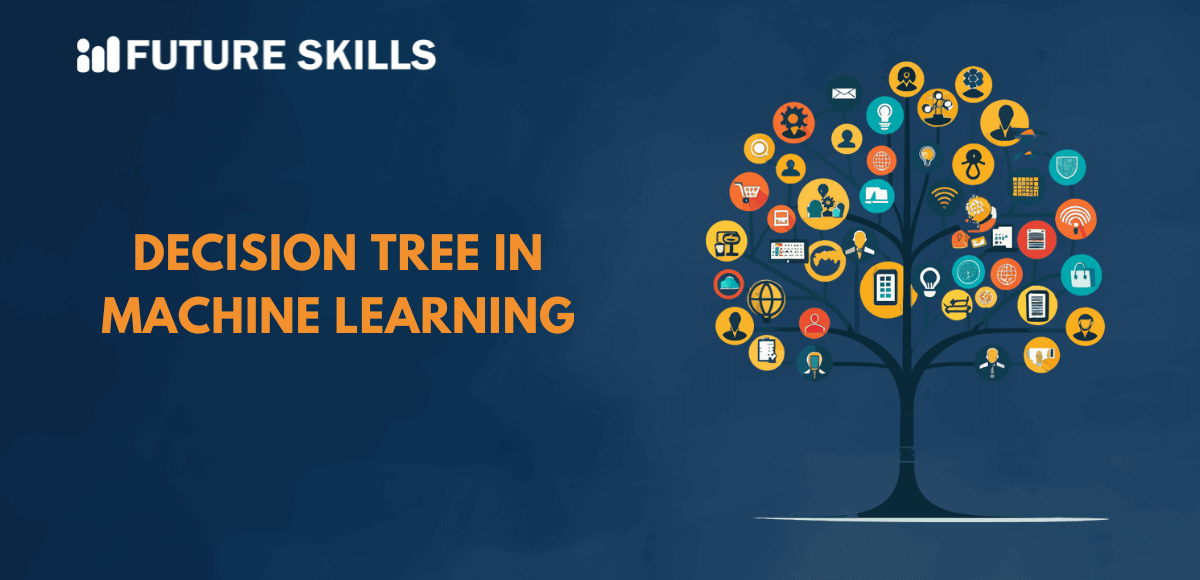Trees serve as the perfect example of growth with the roots, leaves, trunks, and branches showcasing its growth. Decision trees replicate the structure of branches emerging from the trunk which itself grows from the roots. The primary use of decision tree in machine learning revolves around finding an intuitive and clear approach to come up with decisions by unraveling the relationship between variables. From a technical perspective, you can also describe decision trees as versatile algorithms in machine learning that help you with predictive modeling.
One of the best ways to understand decision trees is to assume their representation in the form of a flowchart. The flowchart includes nodes that represent the decisions or different tests on attributes, branches represent the outcome of the decisions and leaves represent the final results. Decision trees work by structuring decisions according to the input data, thereby becoming useful for regression and classification tasks. Let us learn more about decision trees, their working mechanism, and implications for machine learning.
We offer the world’s most advanced Certified AI Professional (CAIP)™ Program to help you succeed in your career. Enroll today!
Understanding the Definition of Decision Trees
Decision trees are supervised learning algorithms that you can use in classification as well as regression modeling tasks. Regression is a trusted method for predictive modeling thereby implying that decision trees can help in data classification or prediction tasks. The answers to queries like ‘What is a decision tree in machine learning?’ would draw your attention towards similarities between decision trees and flowcharts. It is also important to remember that decision trees are useful tools for visualization of the working of supervised learning algorithms.
Decision Trees are important for machine learning as they offer an effective approach to decision-making by outlining the problem and all possible results. It helps developers in effective analysis of the potential outcomes of a decision. When the algorithm gains access to more data, it can come up with predictions for results from future data. Decision trees are useful in the domain of machine learning for visualizing different possibilities as you try to find outcomes.
Demystifying the Architecture of Decision Trees
The architecture of decision trees can offer clear insights into the structure of these trees and the role of individual components. You must also learn about the terms that represent significant facets in the process of making decisions with decision trees. Some of the notable components of a decision tree include root node, internal node, leaf node, and branches. The other terms that you should keep in mind while learning about decision trees include parent node, child node, decision criterion, splitting, and pruning.
Users can identify the significance of decision tree in ML applications by reflecting on the functionality of each component. The root node serves as a representation of the original feature or choice from which the tree leads to branches. Internal nodes or decision nodes determine their choices according to values of specific attributes. Leaf nodes or terminal nodes are the ending points of the branches that represent the final outcome or predictions. The branches in a decision tree represent the links between nodes and the approaches followed for making decisions according to specific circumstances.
The parent node is the original node and the child node is the resultant of splitting of parent nodes. You can discover unique insights on the working of decision trees from important terms like splitting and pruning. Splitting involves dividing a node into two or multiple nodes according to a decision criterion for a specific feature and threshold.
Decision criterion refers to the rule that determines the approach for splitting data at decision nodes by comparing feature values with the threshold. Another important term used with decision trees is pruning, which involves removal of nodes or branches to improve generalization alongside reducing overfitting.
Unraveling the Importance of Decision Trees for Machine Learning
Decision trees serve a transparent explanation for the approaches followed in ML algorithms to come up with specific outcomes. The decision tree machine learning interplay could become more interesting for beginners when they figure out the importance of decision trees for machine learning. You can find multiple reasons for which decision trees have been widely embraced in the domain of machine learning.
Decision trees offer versatility in the simulation of intricate decision-making processes with the flexibility for easy interpretation. The hierarchical structure of decision trees makes them useful for representing scenarios that involve making complex choices. Decision trees also offer clearly understandable insights into decision logic, thereby serving better results in regression and classification tasks.
The flexibility of decision trees is also evident in the support for numerical and categorical data. You can also discover the importance of decision trees for machine learning in the advantage of easier adaptability to different datasets. Another crucial advantage of decision trees is the facility of simple visualization that helps with better understanding of decision-making processes of models.
Learn about the different types of Machine Learning and their implications to use them to your advantage in the best way possible.
Discovering the Notable Variants of Decision Trees
The most common approach for classification of decision trees involves painting them as regression trees or classification trees. Both the decision tree algorithm variants fall under the category of CART or classification and regression tree algorithms. The examples of decision trees that you see today in machine learning borrow their design and working principles from Hunt’s algorithm, created in the 1960s. Hunt’s algorithm has served the foundations for creating some of the notable decision tree algorithms.
ID3 or the ‘Iterative Dichotomiser 3’ is the earliest example of decision trees being used in machine learning. The ID3 decision tree algorithm uses information gain and entropy as the trusted metrics for evaluation of candidate splits. An iteration of ID3 emerged in the form of C4.5 and used gain ratios or information gain to determine the split points in decision trees.
The CART algorithms are the most advanced representation of decision trees in the domain of machine learning. CART decision trees use Gini impurity as a benchmark for identification of the ideal attribute for splitting. The Gini impurity provides a tangible value for the extent of misclassification in a randomly selected attribute. It is important to note that a lower value is recommended for evaluation of splits with Gini impurity.
Master prompt engineering with our Prompt Engineering Certification Course and learn how to interact with AI to generate specific results.
Familiarizing with the Advantages of Decision Trees
The popularity of decision trees might seem like an enigma for beginners who would see no difference between decision trees and flowcharts. You can weigh the importance of decision tree in machine learning by taking a look at their most notable advantages. The most distinctive advantage of using decision trees in different machine learning algorithms is their transparency and simplicity. The following benefits of decision trees can also provide better explanations for the reasons to use them in machine learning.
-
Easier Interpretation
The visual representation in decision trees is obviously one of the top reasons for which you can understand how they generate certain outcomes. It is also important to pay attention to the Boolean logic that makes decision trees more understandable and ensures easier use of their predictions. You should also understand that the hierarchical nature of decision trees makes them more interpretable. Users can easily identify the most important attributes unlike other algorithms in machine learning, such as neural networks.
-
Better Flexibility
The next important advantage of decision trees in the field of machine learning points at the assurance of improved flexibility. You can use decision trees for regression as well as classification tasks. It clearly proves that decision trees offer better flexibility than other algorithms. Decision trees do not consider the underlying relationships between different attributes to make decisions for splitting. If the decision tree finds two highly correlated variables, it would select only one of the features for splitting.
-
Limited Dependence on Data Preparation
Decision trees work with different characteristics that differentiate them from other classifiers. It can manage different data types including discrete or continuous values. Decision trees offer the flexibility for converting continuous values into categorical values by using thresholds. Decision trees can also help in managing missing values unlike other classifiers such as Naïve Bayes.
Familiarize yourself with the Model Validation in Machine Learning and understand the important role it plays to use machine learning techniques effectively.
Can You Encounter Limitations with Decision Trees?
Decision trees are also vulnerable to limitations which may affect the possibilities of their adoption. The foremost setback with decision trees is the possibility of overfitting as they cannot offer effective generalization with new data. However, you can overcome this limitation with the help of pre-pruning and post-pruning processes.
Pre-pruning helps in restricting the growth of decision trees in the case of insufficient data. Post-pruning helps in removing subtrees that have inadequate data after developing the tree. You should also pay attention to the limitation of costs as decision trees follow a greedy search approach. The greedy search approach increases the cost of training a model.
Learn how to integrate AI into your business and grow it rapidly with our unique AI for Business Course. Get started now!
Final Thoughts
The introduction of decision tree in ML algorithms proves that decision trees are groundbreaking tools in the domain of AI. You can use decision trees to obtain a transparent approach for understanding the ways in which supervised algorithms draw inferences. The applications of decision trees can revolutionize decision-making for businesses alongside enhancing operations in other industries. For example, you can use decision trees for better risk assessment and credit scoring in the financial services industry. Learn more about decision trees to unravel new insights about their importance in machine learning now.







